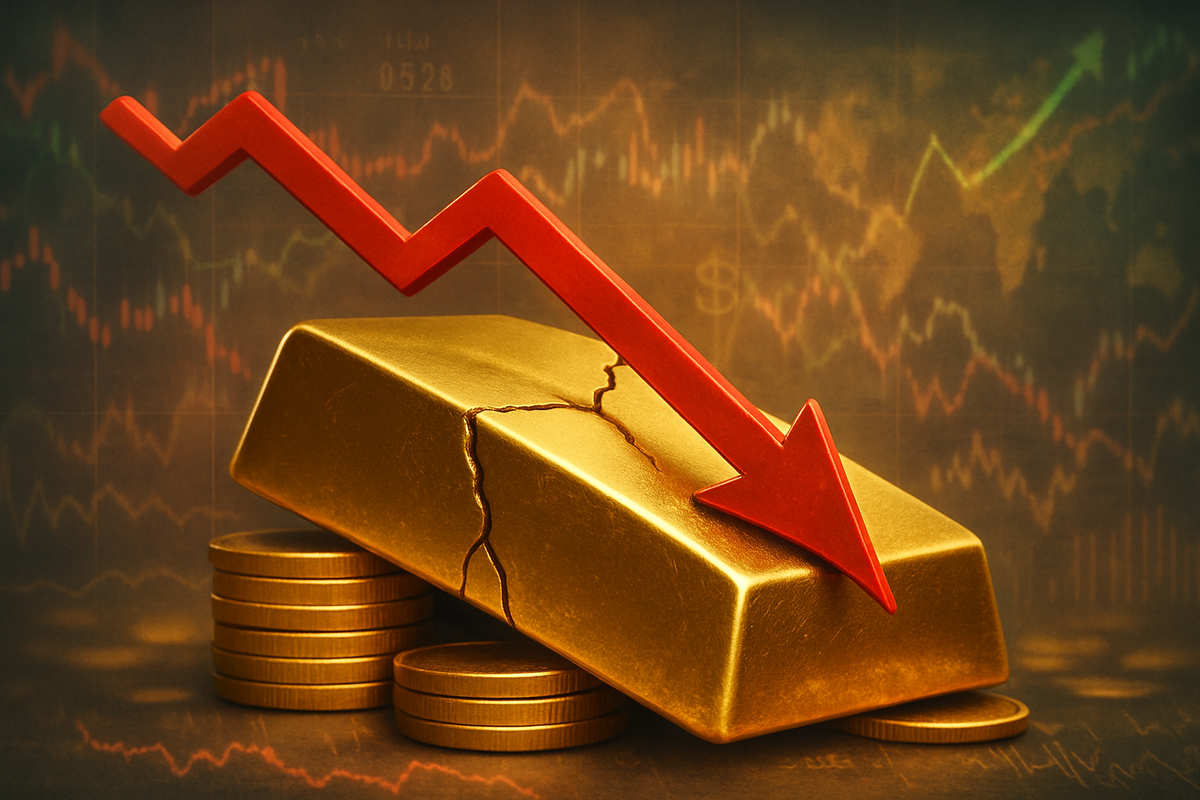
The once-unyielding ascent of gold prices has hit a significant snag, as Truist Advisory Services strategists confirm a sharp market correction as of October 22, 2025. Following an unprecedented rally that saw the precious metal reach record highs, gold experienced its largest single-day decline since 2020, signaling a potential "snapback" from an overstretched market. This immediate implication sends ripples through the financial markets, prompting investors to reassess their positions in what has been a stalwart safe-haven asset. While the short-term outlook appears challenging, with historical data suggesting negative median returns a year after such sharp drops, Truist acknowledges that long-term drivers like central bank buying and geopolitical risks persist.
Truist's "Market Navigator October 2025 edition" explicitly stated that "gold prices appear stretched in the short term" just before the dramatic downturn. This correction is not a result of a singular event but rather a confluence of factors unwinding gold's rapid appreciation, which had pushed prices more than 30% above its 200-day moving average—a deviation not seen since 2006. The market is now grappling with increased volatility and a period of consolidation, as the "rubber band" of gold prices, stretched too far, begins to retract.
Unpacking the Correction: A Timeline of Gold's Volatile Journey
Gold's journey to its recent peak and subsequent correction has been nothing short of dramatic. The metal had been on a remarkable rise since 2024, continuing its strong performance into 2025 and becoming the best-performing major asset over the past year. This rally saw gold climb approximately 25% in 2024, setting 40 new all-time highs and peaking around US$2,778 per ounce in late October. Central banks were significant buyers, adding 337 tonnes in Q3 2024, while global gold ETFs saw net inflows after seven quarters of outflows.
The momentum continued into 2025, with gold breaking above US$3,000 per ounce for the first time in March. Despite a brief correction phase in mid-April 2025, which saw an 11% decline from peaks by June, gold roared back. In September 2025, a 25 basis point interest rate cut by the Federal Reserve, with expectations of further cuts, provided significant tailwinds. Gold gained 20% from this initial easing through October 21. Early October saw gold surpass $4,000 per ounce on October 8, achieving its 45th new all-time high of the year, with the move from $3,500/oz to $4,000/oz taking just 36 days. The pinnacle was reached on October 21, 2025, when gold hit an unprecedented peak of $4,381 per ounce, marking a nearly 54% year-to-date gain and its strongest annual performance since 1979.
However, the very next day, October 21-22, 2025, witnessed a dramatic reversal. Gold experienced its largest single-day decline in five years, plunging by as much as 6.3% intraday to briefly trade near $4,106.46 per troy ounce, extending losses to around $4,035-$4,067.31 on October 22. This sharp sell-off was driven by a confluence of technical, economic, and sentiment factors. Technically, gold was in an "extremely overbought" condition, ripe for profit-taking, and broke key technical patterns and support levels. Economically, a stronger U.S. Dollar Index made gold more expensive, and easing inflation concerns, despite anticipated Fed rate cuts, shifted market dynamics. Investor sentiment saw a rotation from safe-haven assets to "risk-on" assets due to easing geopolitical tensions, particularly improved U.S.-China trade relations, and softer physical demand post-Diwali. Initial market reactions were a broad precious metals sell-off, significant declines in gold mining stocks like Newmont (NYSE: NEM) and Barrick Gold (NYSE: GOLD), and increased volatility, though many analysts viewed it as a "healthy correction" within a broader bullish trend.
Corporate Crossroads: Winners and Losers in Gold's Correction
The recent gold price correction has sent shockwaves through the public companies tied to the precious metal, creating a clear divide between potential winners and losers. Gold mining companies, in particular, face amplified effects due to their operational gearing, where a small percentage drop in gold prices can lead to a disproportionately larger fall in profits and stock valuations.
Potential Losers: High-cost producers are most vulnerable, facing severe profit margin compression. If prices dip below their "all-in sustaining costs" (AISC), mines can become unprofitable, leading to operational cutbacks or project deferrals. Heavily indebted miners and junior mining companies, with less diversified portfolios and higher financing challenges, are also at significant risk of project delays or even solvency issues. Major producers like Newmont Corporation (NYSE: NEM), Barrick Gold (NYSE: GOLD), Kinross Gold (TSX: K, NYSE: KGC), and Agnico Eagle (NYSE: AEM) have already seen their stock prices under pressure, with the VanEck Gold Miners ETF (NYSE Arca: GDX) dropping 9.4% and Newmont falling 9%. Australian miners such as Northern Star Resources (ASX: NST) and Evolution Mining (ASX: EVN) are also experiencing downward momentum.
Potential Winners and Resilient Players: Companies with low production costs and strong balance sheets are better positioned to weather the storm, maintaining healthier margins. Examples include Centerra Gold, Lundin Gold, and Perseus Mining (based on Q3 2023 data), as well as Allied Gold (TSX: AAUC, NYSE: AAUC) with its improved AISC. Gold streaming and royalty companies like Franco-Nevada Corporation (NYSE: FNV) and Wheaton Precious Metals Corp. (NYSE: WPM) typically exhibit lower volatility, as their business model reduces exposure to direct operational costs. Short sellers, who bet against gold or gold mining stocks, would have realized significant profits. Additionally, long-term institutional investors may view this sharp decline as a strategic buying opportunity, accumulating quality assets at a discount. Companies with effective hedging strategies will also mitigate revenue losses. Indirectly, industries using gold as a raw material, such as jewelry manufacturers, might see reduced input costs, potentially boosting their margins.
The implications for these companies are profound. Stock prices for gold miners often exhibit a leveraged response to gold prices, amplifying movements by 2x to 3x, meaning the correction leads to more dramatic declines in mining equities. Profitability is directly squeezed, forcing companies to renew focus on rigorous cost management, operational efficiency, and potentially cut capital expenditures and exploration budgets. This period could also catalyze mergers and acquisitions (M&A) as stronger players seek to acquire weaker competitors or high-quality assets at a discount, reshaping the industry landscape. Gold-backed ETFs like SPDR Gold Shares (NYSEARCA: GLD) will see direct NAV declines, while gold mining ETFs like VanEck Gold Miners ETF (NYSE Arca: GDX) will experience even larger percentage drops. Conversely, inverse gold ETFs, such as Direxion Daily Junior Gold Miners Index Bear 2X Shares (NYSE Arca: JDST), are designed to profit from such declines.
Broader Implications: Gold's Role in a Shifting Global Landscape
The current gold price correction, marked by its sharp nature and comparison to the worst single-day drop since 2013, extends beyond immediate market volatility, fitting into several broader industry trends and carrying significant ripple effects. Despite the dip, gold's fundamental role as a safe-haven asset and inflation hedge remains largely intact, a testament to its enduring appeal during economic instability and currency depreciation. A key trend reinforcing this is the sustained and substantial demand from central banks globally, particularly in emerging markets. Driven by diversification away from the U.S. dollar and geopolitical risks, this institutional buying is expected to provide a "strong floor" for gold prices, preventing deeper corrections and signaling a broader de-dollarization effort.
The correction's ripple effects are felt across the precious metals ecosystem. Beyond gold miners, other precious metals like silver and platinum, which often move in tandem, also experienced sharp declines, indicating amplified volatility across the broader precious metals market. The jewelry industry faces a mixed bag: those with high inventory purchased at peak prices may face write-offs, while a sustained lower price could stimulate consumer demand for jewelry, particularly for mass-market items, and benefit jewelers with agile inventory management or leasing arrangements. Industrial users, such as electronics and automotive sectors, might benefit from reduced input costs. Regulatory bodies are also taking note; the speed and severity of the correction could prompt enhanced oversight of precious metals markets. Indeed, the National Stock Exchange (NSE) in India has already increased margin requirements for gold and silver futures in October 2025 to curb speculation. Furthermore, such market "yellow flags" could influence central bank monetary policy adjustments and highlight a potential shift towards national debt management over strict inflation control, especially with the ongoing phased implementation of Basel III reclassifying gold as a Tier 1 asset.
Historically, gold has experienced significant corrections, often described as "breathers" within broader bull markets. The 1980 collapse due to aggressive Fed rate hikes, the 2013 drop following quantitative easing signals, and the post-COVID-19 rally and subsequent correction all serve as precedents. These events underscore gold's sensitivity to monetary policy, the U.S. dollar's strength, and speculative bubbles. While the current correction is severe, historical patterns and expert forecasts suggest that gold often rebounds, particularly given persistent global economic uncertainties, geopolitical fragmentation, and continued institutional demand. The long-term outlook, supported by these enduring factors, is generally viewed as bullish, with analysts forecasting new record highs in the coming years, suggesting this correction might be a temporary pause rather than a fundamental reversal.
The Path Forward: Gold's 12-Month Trajectory and Strategic Imperatives
As of October 22, 2025, the gold market stands at a critical juncture, navigating the aftermath of a significant correction but with a predominantly bullish long-term outlook for the next 12 months. In the short term (Q4 2025 - Q1 2026), gold prices are expected to enter a consolidation phase around the $4,000 per ounce level. While volatility will persist due to profit-taking and shifts in Federal Reserve policy, many analysts view this period as offering strategic "buying opportunities on dips" rather than a signal for a sustained downturn. Upcoming economic data, particularly US CPI reports, will be closely watched, as hotter-than-expected inflation could impact the likelihood of December rate cuts, potentially influencing gold's immediate trajectory.
Looking further out into mid-2026, the consensus among major financial institutions remains optimistic. Forecasts from leading banks like Goldman Sachs, UBS, HSBC, Bank of America, and Société Générale project significant price appreciation, with targets ranging from $4,000 to $5,000 per ounce. This bullish outlook is underpinned by several key drivers: persistent central bank demand, particularly from emerging markets diversifying away from the U.S. dollar; anticipated easing monetary policy and interest rate cuts by the Federal Reserve through 2026, which reduce the opportunity cost of holding non-yielding gold; ongoing geopolitical risks and economic uncertainties; strong ETF inflows; and gold's role as a hedge against inflation and concerns about rising global public debt. A projected weakening of the U.S. dollar would also make dollar-denominated gold more attractive internationally.
For market participants, strategic pivots and adaptations are crucial. Diversification and robust risk management are paramount to navigate potential price swings. Investors are advised to view dips as long-term buying opportunities, accumulating gold for portfolio insurance rather than chasing short-term gains. Exploring alternatives like gold royalty companies (e.g., Franco-Nevada Corporation (NYSE: FNV)) can offer a potentially safer exposure. Continuous monitoring of intermarket correlations and adjusting hedging strategies will also be vital. Emerging markets present both opportunities and challenges; their central banks are significant drivers of structural demand, but these regions may also face headwinds from commodity price volatility and trade disputes. Potential scenarios range from a base case of gradual appreciation towards $4,000-$4,500, to a bullish scenario where a "crisis of confidence" or major geopolitical escalations could drive prices above $5,000. A less likely bearish scenario, driven by a strong economic recovery and sustained high real interest rates, could pressure prices, but this is not the prevailing expert view.
Gold's Resilient Future: Key Takeaways and Investor Watchpoints
The recent gold price correction, while sharp and impactful, appears to be a "healthy reset" within a broader, ongoing bull market for the precious metal. The swift decline from record highs, as identified by Truist and other market analysts, was largely a technical unwinding of an overbought market, coupled with profit-taking and some easing of short-term geopolitical tensions. However, the underlying fundamental drivers that propelled gold to unprecedented levels throughout 2025 remain firmly in place, suggesting that this correction is a temporary phase rather than a fundamental reversal.
Moving forward, the market is expected to consolidate around the $4,000 per ounce mark, with short-term volatility giving way to a renewed upward trajectory over the next 12 months. The persistent demand from central banks, ongoing global geopolitical and economic uncertainties, and the anticipated easing of monetary policy by the U.S. Federal Reserve are all strong tailwinds for gold. These factors solidify its role as a crucial portfolio diversifier and a hedge against inflation and systemic risks. Investors should consider this correction an opportune moment to accumulate gold and gold-related assets, focusing on quality and long-term strategic positioning.
What investors should watch for in the coming months includes the Federal Reserve's actual interest rate decisions and forward guidance, any significant shifts in global geopolitical landscapes, and key economic indicators such as inflation data and the strength of the U.S. dollar. Continued central bank buying activity and trends in gold ETF flows will also provide crucial insights into market sentiment and demand. While the path ahead may involve further volatility, the consensus points towards gold maintaining its luster, with many experts projecting new record highs in the medium to long term. The current correction, therefore, should be viewed as a recalibration, preparing gold for its next phase of growth in an increasingly uncertain global financial environment.
This content is intended for informational purposes only and is not financial advice




